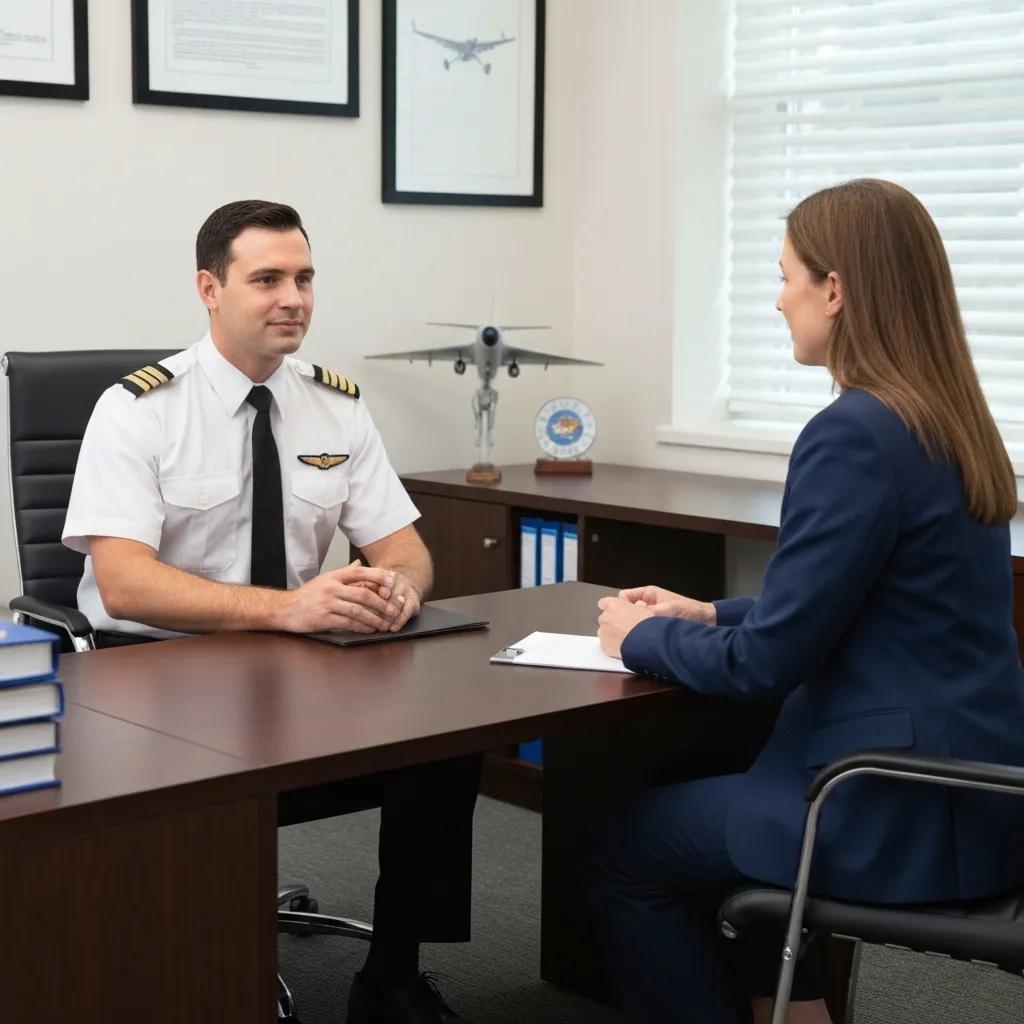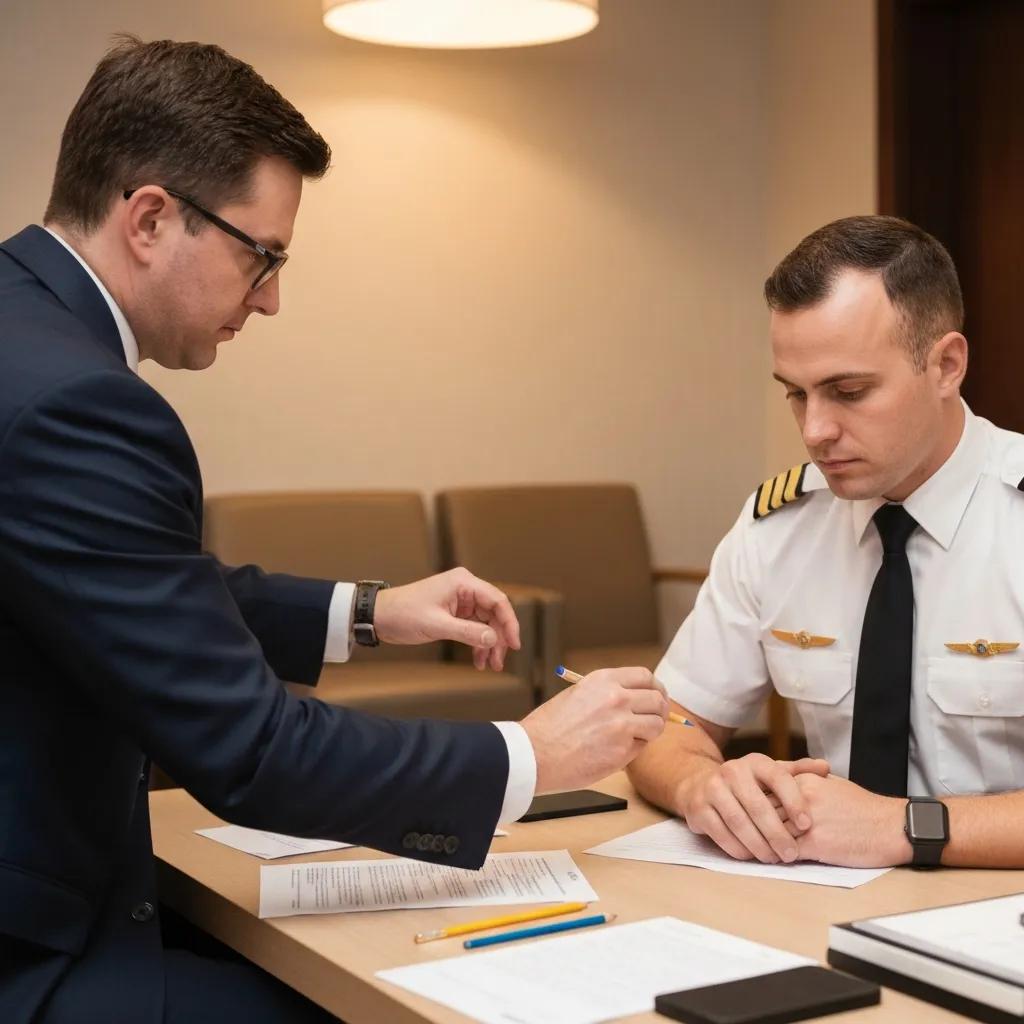Blog

Elevate Safety with Pilots Psychological Evaluation Services
FAA Pilot Psychological Evaluations — Protecting Safety and Supporting Pilot Mental Health
A pilot psychological evaluation is a focused, FAA-aligned mental health assessment that determines fitness for duty, guides safe return-to-duty plans, and protects both aviation safety and a pilot’s career. This resource explains what those evaluations look like, why the FAA requires them, and practical steps pilots can take — including discreet support and targeted therapy — to address concerns. Our goal is simple: help pilots get the care they need while clarifying the regulatory context that affects medical certification. Below we cover definitions and regulatory rationale, how diagnosis-light services can reduce career risk, a step-by-step evaluation pathway, recent FAA policy trends and HIMS context, common pilot questions with practical answers, and brief FAQs. Throughout we reference clinical assessments (including cognitive and personality measures), AME coordination, and options for California pilots seeking telehealth or in‑person care.
What Is an FAA Pilot Psychological Evaluation and Why Is It Required?
An FAA pilot psychological evaluation is a structured assessment of mental health, cognitive functioning, and readiness for flight duties used to inform certification and safety decisions. The process combines a clinical interview, records review, and standardized tests to identify conditions that could impair judgment, cognition, or behavior during flight. Its primary purpose is to protect public safety while giving pilots a clear pathway to address health issues and maintain or regain certification. Evaluations also help Aviation Medical Examiners (AMEs) and federal reviewers turn treatment and monitoring recommendations into practical, time‑limited plans that support a safe return to duty.
The exact assessment depends on who requested it: AME-initiated reviews, FAA-directed evaluations, employer fitness-for-duty exams, or voluntary evaluations from pilots. Regardless of the referral source, the core aims are the same—objective documentation, treatment guidance, and clear recommendations that AMEs can use for medical-certification decisions. Knowing these shared elements reduces uncertainty and clarifies how findings affect certification timelines.
Pilots often ask why the FAA requires psychological evaluations. In short: they reduce risk and enable informed medical decisions. Key reasons the FAA relies on these assessments are below.
To confirm a pilot’s cognitive and emotional functioning meets safety-critical standards.
To provide objective data AMEs and federal reviewers can use when assessing certification and monitoring needs.
To create structured pathways for treatment and supervised return-to-duty that protect the public and preserve pilots’ livelihoods.
Together, these goals show how evaluations balance safety with opportunities for treatment and monitored return to flight.
What Does an Aviation Mental Health Assessment Involve?

An aviation mental health assessment usually starts with a thorough clinical interview covering current symptoms, psychiatric history, substance use, sleep, and any operational impact. Clinicians review medical records, prior evaluations, AME notes, and collateral information to form an objective picture, then select standardized measures to evaluate cognition and personality when indicated. Common domains include attention, memory, executive function, mood, anxiety, and substance‑use risk; each helps clarify fitness‑for‑duty questions for AMEs. Findings are integrated into a clear report that links test results to functional abilities and recommended monitoring or treatment.
These elements create a dependable basis for FAA‑aligned recommendations and give pilots actionable next steps. The findings also indicate whether specialized referrals—such as neuropsychological testing or CogScreen‑AE—are needed to answer specific cognitive questions raised by an AME or employer.
Why Does the FAA Require Psychological Evaluations for Pilots?
The FAA requires psychological evaluations because mental health and cognition affect decision‑making, situational awareness, and the ability to manage complex flight tasks under stress. Federal regulations and aeromedical guidance (including 14 CFR Part 67 and AME advisories) direct medical examiners to identify conditions that could compromise safety while promoting appropriate treatment. Recent policy shifts emphasize early care and greater AME discretion for uncomplicated cases, reducing barriers to help when punitive action isn’t warranted. That balance is intended to prevent accidents while preserving pilots’ careers through monitored, evidence‑based recovery pathways.
Understanding the FAA’s rationale helps pilots choose between voluntary care and formal evaluation and reduces fear of seeking help. When pilots and clinicians coordinate with AMEs and follow accepted monitoring practices, many treated conditions can be managed in ways that maintain or restore certification.
How Does Stephen Rought LLC Provide Specialized Psychological Evaluation Services for Pilots?
Stephen Rought LLC provides pilot‑sensitive psychological services that align with FAA expectations while prioritizing discretion and career protection. When appropriate, we use a diagnosis‑light, skills‑based approach that blends clinical assessment and targeted therapy with FAA‑useful reporting. Our clinical model emphasizes practical, goal‑directed therapies like Cognitive Behavioral Therapy (CBT) to address performance anxiety, fatigue‑related symptoms, and operational stressors. Reports are concise and functional—focused on observable performance and clear recommendations—so AMEs can use them in certification decisions. Pilots who want to minimize diagnostic labeling can pursue discreet consultations that focus on skills, coping, and stability while preserving certification support options. The practice supports pilots via secure telehealth across California and in‑person visits at Chino Hills, and accepts Aetna and Medicare for covered services. These options are designed to fit pilots’ schedules and privacy needs so aviators can get care without unnecessary career risk.
Below is a quick comparison of our service offerings to help pilots choose the right pathway.
Service TypeWho It's ForWhat It IncludesFAA RelevanceConfidential ConsultationPilots seeking non‑diagnostic supportIntake, short‑term skills work, coping strategiesCareer‑protective; reduces need for formal diagnosis when appropriateFAA-Aligned EvaluationAME or FAA referralsClinical interview, records review, testing recommendations, formal reportDirectly supports AME certification decisionsOngoing Therapy & MonitoringPilots in treatment or HIMS pathwayCBT, progress tracking, agreed monitoring scheduleDocuments stability and supports return‑to‑dutyTelehealth Follow-UpCalifornia‑based pilots statewideSecure video sessions, flexible schedulingMaintains continuity without travel
This comparison shows how each service maps to pilot needs and FAA processes. Choosing the right option starts with deciding whether the priority is private support, a formal evaluation, or monitored treatment.
What Discreet, Diagnosis-Free Support Is Offered for Aviation Professionals?
Diagnosis‑free support focuses on symptom management, skill building, and functional improvement without emphasizing formal psychiatric labels—when clinically appropriate. Clinicians offer targeted interventions such as CBT for anxiety, sleep stabilization strategies, and stress inoculation that address operational impairment while documenting progress in neutral, functional terms if reporting is required. Confidential consults limit unnecessary record‑sharing; disclosures to AMEs or employers happen only with informed consent or when legally required. This approach reduces stigma and encourages earlier engagement, which often improves outcomes and shortens monitoring.
Practical confidentiality measures include secure telehealth platforms, limited‑release documentation tailored for aviation reviewers, and clear informed‑consent conversations about when and how information may be shared. These safeguards let pilots pursue care without automatically triggering punitive certification actions, aligning clinical care with career‑protective goals.
How Are Online and In-Person Therapy Options Tailored for Pilots?
Telehealth lets California pilots access care around irregular schedules and travel, using secure video sessions that fit early‑morning, evening, or off‑duty windows. In‑person visits at our Chino Hills office are available for pilots who prefer face‑to‑face care or need local documentation for an AME. Flexible scheduling, short‑notice availability, and focused session formats make therapy practical for pilots balancing flight hours and training. Clinicians adapt interventions to operational realities, emphasizing brief, goal‑directed work that targets safety‑relevant symptoms and resilience.
When therapy is framed around FAA concerns, sessions focus on measurable functional goals—sleep regularity, anxiety reduction, cognitive pacing—that can be documented objectively. We accept Aetna and Medicare for covered services, and private‑pay options are available for pilots prioritizing privacy.
What Is the Step-by-Step Process of a Pilot Psychological Evaluation with Stephen Rought?
How Does the Initial Consultation Establish Confidentiality and Needs?
The initial consultation defines the evaluation scope, clarifies confidentiality limits, and identifies the pilot’s goals—whether that means therapy, a formal FAA‑aligned evaluation, or referral to a HIMS specialist. In that first meeting, pilots are encouraged to describe concerns in a safe, nonjudgmental setting; this reduces barriers to care and sets realistic expectations for documentation. Clinicians review informed consent, outline which records will be requested (medical notes, AME letters, employer reports), and explain when disclosures to AMEs or federal reviewers may be necessary. This visit also distinguishes voluntary, diagnosis‑free support from FAA‑directed assessment so pilots can choose the pathway that best protects their career.
The intake clarifies timelines, likely testing needs, and whether specialized referrals—such as neuropsychological testing or CogScreen‑AE—are probable. Knowing these steps early helps pilots coordinate with their AME and meet employer requirements.
Initial consultation: Define scope, confidentiality, and goals; plan records requests.
Records review: Collect medical, flight, and collateral documentation for context.
Testing and assessment: Conduct clinical interviews and standardized cognitive/personality measures as indicated.
FAA-aligned report: Integrate findings into objective recommendations for AMEs or federal reviewers.
Follow-up and monitoring: Implement therapy, progress tracking, or HIMS coordination as needed.
StepPurposeTypical TimeframeDeliverableInitial ConsultationDefine scope and consent1–2 weeks schedulingTreatment plan / assessment scopeRecords ReviewCollect AME notes, medical history1–3 weeksAnnotated records summaryTestingCognitive and personality assessment1–4 weeksTest score profilesReport WritingFAA‑aligned recommendations1–3 weeks post‑testingFormal evaluation reportFollow-upTherapy and monitoringOngoing as agreedProgress notes and monitoring plan
What Assessments and Testing Are Included in the Evaluation?
Assessments commonly include a structured clinical interview, standardized personality inventories, cognitive screens, and targeted symptom measures for mood, anxiety, sleep, and risk behaviors. If cognitive issues arise, clinicians may recommend neuropsychological testing or a CogScreen‑AE referral—tools some AMEs and federal reviewers use to evaluate aviation‑relevant cognitive domains. Substance‑use screening and collateral information are included when indicated to provide a complete, objective view of functioning. Test selection is driven by the presenting concern and the goal of producing FAA‑relevant, function‑focused results.
When specialized tests aren’t available in‑house, referrals are coordinated with pilots and AMEs to ensure continuity and minimize delays. Objective testing helps distinguish transient, remediable issues from persistent deficits that need longer monitoring.
How Are FAA-Aligned Reports and Recommendations Prepared?
Reports are written to be concise, objective, and directly useful to AMEs. They include a clear statement of the referral question, a summary of records and interview findings, interpreted test results, and practical recommendations about fitness‑for‑duty, treatment, and monitoring. Language is intentionally functional—focused on operational impact, recommended monitoring duration, and observable markers of stability—so AMEs can integrate findings into certification decisions. With consent, clinicians can communicate with AMEs and provide the documentation that supports a safe return‑to‑duty.
Report timelines depend on testing needs but are structured to meet AME and FAA scheduling. Clear, action‑oriented recommendations shorten review cycles and help pilots and AMEs agree on an evidence‑based plan.
What Ongoing Support and Follow-Up Therapy Are Available?
Ongoing support and follow-up therapy ranges from short‑term, goal‑directed therapy to longer‑term CBT for performance and resilience, plus monitoring plans tailored to FAA or HIMS requirements. Progress is documented with standardized symptom measures and session summaries tracking sleep, mood, cognition, and operational behaviors. For pilots in HIMS or other monitored pathways, clinicians provide agreed reporting schedules and collaborate with AMEs and occupational programs to document sustained stability. Relapse‑prevention planning and contingency strategies are part of follow‑up to maintain flight safety over time.
This continuum—from discreet consults to formal monitoring—lets pilots get timely care while preserving routes for certification and career continuity.
How Does the FAA’s Evolving Stance Impact Pilot Mental Health and Certification?
The FAA’s approach has shifted toward reducing stigma and encouraging treatment while keeping strict safety standards. Recent guidance expands AME discretion for uncomplicated anxiety and depression when pilots show stability and are in appropriate treatment. The goal is to lower barriers to seeking help and clarify when AMEs can manage cases without automatic federal review. At the same time, the FAA still requires formal evaluations and HIMS pathways for substance‑related or high‑risk cases to protect public safety during return‑to‑duty processes.
Pilots who pursue treatment early, document improvements, and communicate with their AME are better aligned with current FAA expectations. Early, documented intervention often shortens monitoring and increases the chance of maintaining certification when it’s safe to do so.
What Are the Latest FAA Guidelines on Anxiety, Depression, and Mental Health?

Recent FAA guidance clarifies that AMEs may manage certain uncomplicated cases of anxiety or depression when pilots are stable, engaged in treatment, and not taking disqualifying medications. Key factors include symptom severity, functional impact on flight duties, documented treatment response, and absence of safety concerns such as suicidal ideation or substance misuse. The guidance encourages clinicians and AMEs to document objective stability and use time‑limited monitoring when appropriate. Pilots are advised to consult an AME early; coordinated care with mental health specialists supports favorable outcomes under this evolving framework.
Knowing these benchmarks helps pilots choose the right care pathway—voluntary, discreet therapy may be sufficient for mild cases, while formal evaluations suit more complex presentations.
How Does the HIMS Program Support Pilots’ Return to Duty?
The HIMS program (Human Intervention Motivation Study) provides an FAA‑approved, structured path for pilots with substance‑use or certain health issues to achieve monitored recovery and return to flight status. HIMS combines coordinated clinical care, objective monitoring (for example, toxicology when indicated), and structured reporting that demonstrates sustained stability. Certified HIMS clinicians work with AMEs, employers, and occupational programs to build stepwise return‑to‑duty plans balancing safety and rehabilitation. For pilots who need this pathway, HIMS offers an evidence‑based route to restore certification under supervised conditions.
Experienced HIMS clinicians can shorten timelines and reduce recidivism through targeted interventions and consistent communication with aviation medical stakeholders.
What Are Common Pilot Concerns About Psychological Evaluations and How Are They Addressed?
Pilots commonly worry about losing their medical certificate, career consequences, and confidentiality when seeking mental health care. Addressing these concerns means explaining the FAA’s safety rationale, clarifying confidentiality limits, and outlining strategies—like diagnosis‑light consults and early AME communication—that reduce career risk. Stigma is another concern; confidential, skills‑focused treatment and objective documentation of stability protect careers while improving health. Clear planning and coordination with an AME or HIMS specialist provide a structured path for safe return to duty.
Sharing anonymized examples and clear process descriptions reduces uncertainty and encourages pilots to seek help sooner—an outcome that benefits both individual wellbeing and aviation safety.
Can Pilots Receive Therapy Without Losing Their Medical Certificate?
Yes—many pilots receive therapy without losing their medical certificate, particularly when they pursue voluntary, documented treatment and coordinate with an AME. FAA and AME guidance increasingly supports treatment and monitored recovery for uncomplicated conditions, and pilots often keep certification while in therapy if symptoms don’t impair flight safety. Best practices include early AME consultation, using objective measures to document improvement, avoiding disqualifying substances, and, if privacy is a concern, discussing self‑pay options versus insurance billing to manage record flows.
Proactive, well‑documented steps are the most reliable way to protect certification while getting care.
How Is Confidentiality Maintained for High-Stakes Aviation Professionals?
Confidentiality is maintained through clinical practices that limit record sharing to consented recipients, use secure telehealth platforms, and craft reports in neutral, function‑focused language for AMEs. Clinicians explain confidentiality limits—including legal exceptions—during informed consent and obtain explicit permission before releasing records. When FAA‑useful documentation is required, clinicians aim to balance necessary transparency with career‑preserving phrasing that emphasizes functional status and monitoring plans rather than stigmatizing diagnostic labels. These practices protect pilots’ privacy while meeting aeromedical reporting needs.
This approach reduces unnecessary disclosures and makes it easier for pilots to seek care without fearing automatic punitive outcomes.
What Success Stories Illustrate Positive Outcomes for Pilots?
Anonymized examples show common positive outcomes: a commuter pilot who used discreet CBT for performance anxiety, documented rapid symptom improvement, and maintained certification while regaining confidence; a long‑haul pilot who completed a structured monitoring plan with objective sleep and mood measures and restored full medical status; and a pilot in a HIMS pathway who, after consistent treatment and monitoring, returned to flying under supervised clearance. Each example highlights early engagement, clear documentation, and close coordination with an AME as key to successful return‑to‑duty outcomes.
These cases demonstrate that timely, well‑documented care combined with FAA‑aligned reporting often leads to safe, career‑preserving results.
Frequently Asked Questions
What are the benefits of undergoing a pilot psychological evaluation?
A pilot psychological evaluation provides clear safety benefits for both the pilot and the flying public. Evaluations identify mental health or cognitive issues that could affect performance and offer a structured path for treatment and recovery. Participating in an evaluation can help pilots address concerns while preserving or restoring medical certification, with recommendations that support safe return to duty.
How can pilots prepare for their psychological evaluation?
To prepare, pilots should collect relevant medical records, prior evaluations, and any AME documentation. Reflecting on current symptoms and operational impacts helps during the clinical interview. Being open and factual in the interview lets clinicians understand the pilot’s situation and recommend appropriate testing or treatment. Familiarizing yourself with the evaluation steps reduces anxiety and sets realistic expectations.
What happens if a pilot does not pass the psychological evaluation?
Not passing an evaluation does not necessarily end a pilot’s career. An evaluation may identify areas that need treatment or monitoring. Pilots can work with clinicians to create a targeted treatment plan and document progress. With appropriate intervention and objective evidence of improvement, many pilots can regain medical certification. Ongoing communication with an AME and following recommended steps are essential.
Are there specific mental health conditions that are more common among pilots?
Certain conditions appear more often in pilots due to the job’s demands. Anxiety, depression, and substance‑use disorders are commonly reported, and sleep disorders are frequent because of irregular schedules and circadian disruption. Early recognition and timely intervention through evaluations can help pilots maintain mental health and operational effectiveness.
How does the FAA's evolving stance on mental health affect pilots?
The FAA’s evolving stance is more supportive of treatment and early intervention. Current guidance allows AMEs to manage uncomplicated cases of anxiety and depression when pilots show stability and are in treatment. This shift aims to reduce stigma and encourage pilots to seek care early, improving safety and certification outcomes. Open communication with an AME and documented progress align with these expectations.
What role does confidentiality play in pilot psychological evaluations?
Confidentiality is central to encouraging pilots to seek help. Clinicians follow strict privacy practices, sharing information only with consent or when legally required. Reports are written in neutral, functional language that focuses on abilities and monitoring rather than stigmatizing diagnoses. This balance protects careers while allowing pilots to get necessary support.
What Conditions Require an FAA Pilot Psychological Evaluation?
Common triggers for FAA‑ordered or AME‑referred psychological evaluations include suicide attempts, psychosis, certain substance‑use concerns, cognitive complaints after head injury or illness, and performance‑related safety incidents. Some diagnoses disclosed on FAA medical forms or reported to an AME may also require formal assessment to determine fitness for duty. Voluntary therapy for mild symptoms doesn’t always lead to a formal FAA evaluation, but pilots should consult an AME if unsure.
Common triggers include suicide attempts, psychotic episodes, substance misuse, and significant cognitive complaints.
Performance incidents or employer referrals can also prompt evaluations.
Pilots uncertain about a condition should consult an AME for guidance.
Early consultation with an AME reduces surprises and supports coordinated care.
How Long Does a Pilot Psychological Evaluation Take?
Timelines depend on complexity: initial consultation and records requests typically occur within 1–2 weeks, testing and reviews often take another 2–6 weeks, and report writing can add 1–3 weeks after testing. Simple evaluations without extensive testing may finish in 3–6 weeks; complex cases requiring neuropsychological testing or outside referrals can take several months. Factors that affect duration include specialized test needs, time to obtain past records, and pilot scheduling constraints.
Pilots with urgent certification deadlines should share those dates early so clinicians can prioritize records gathering and testing.
Do You Accept Insurance for Pilot Mental Health Services?
Stephen Rought LLC accepts Aetna and Medicare for covered services, which can lower out‑of‑pocket costs for therapy and evaluations when applicable. Pilots should know that using insurance may create clinical records accessible through billing or claims; those concerned about privacy can discuss self‑pay options to limit external documentation. For formal FAA‑aligned evaluations, coordination with AMEs and documentation requirements may necessitate shared records; clinicians will explain implications during intake.
AssessmentWhat It MeasuresWhy It's Used in Aviation EvaluationsClinical InterviewSymptom history and functional impactFoundation for diagnosis and FAA reportPersonality InventoriesTrait profiles that affect behaviorClarifies risk factors and coping stylesCognitive ScreensAttention, memory, executive functionDetects deficits that could affect flight safetyCogScreen-AE (referral)Aeromedical cognitive domainsUsed by AMEs and federal reviewers for complex casesSubstance ScreensRecent use and severityCritical for safety decisions and HIMS pathways
How Can Pilots Find a HIMS Psychologist in California?
Pilots seeking HIMS‑trained clinicians in California can check FAA and professional directories, consult HIMS resources, or ask clinicians for referral assistance. Telehealth widens access to certified providers statewide, and practices that accept consultation requests for HIMS can help streamline referrals. Stephen Rought LLC can assist with referrals and offers telehealth across California plus in‑person support at the Chino Hills office; pilots should discuss needs during an initial consultation to receive tailored guidance.
Search FAA and professional organization resources for HIMS directories.
Ask clinicians for referrals if they don’t offer HIMS services directly.
Use telehealth to access HIMS providers statewide in California.
If you’re ready to take the next step, contact Stephen Rought LLC to discuss discreet evaluations or therapy by phone or schedule a telehealth consult at the Chino Hills office. Our practice serves as an information and referral hub, accepts Aetna and Medicare, provides statewide telehealth in California, and offers a dedicated Therapy for Pilots service. We encourage pilots and aviation professionals to remember the core purpose of seeking care: reach out for help when you need it, with clinical guidance that safeguards both safety and career continuity.
Contact pathway: Call the practice phone to arrange intake and scheduling.
Privacy options: Discuss self‑pay versus insurance and privacy implications during intake.
Referrals: Request HIMS or specialized testing referrals if required.

Stephen Rought, LCSW
Proudly Accepting
Aetna and Medicare Insurance


Disclaimer
Stephen Rought, LCSW does not guarantee any specific outcome. All content provided on the Stephen Rought, LCSW website is provided for educational or informational purposes only. Consult medical professionals you are working with about whether any opinions or recommendations provided through this website apply to you and your unique circumstances
Currently, all online therapy sessions are conducted using the HIPPA compliant Telehealth service doxy.me
SErvices
Individual Therapy
Parent Coaching
Financial Therapy
Couples Counseling
Family Therapy

